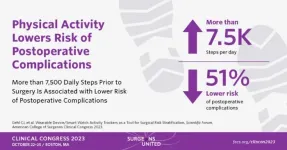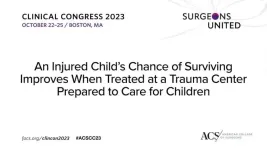(Press-News.org) Key takeaways
Using Fitbit activity tracking data, researchers identified patients who might be at higher risk of postoperative complications. Fewer daily steps were associated with a higher rate of complications postoperatively.
The odds of complications within 90 days after hospital discharge were reduced by half if a patient took more than 7,500 steps a day before the operation, after adjusting for the complexity of the procedure, comorbidities, and other factors.
CHICAGO (October 20, 2023): Patients who recorded more walking activity prior to surgery, regardless of complexity of the operation or their health status, showed 51% reduced odds for postoperative complications than less active patients, according to research findings being presented at the American College of Surgeons (ACS) Clinical Congress 2023.
Postoperative complications typically occur in about 30% of patients,1 and about half of all complications occur after the patient leaves the hospital.2
“Fitbits and other wearable devices could potentially be linked to Electronic Health Records (EHRs) and have that data be something that surgeons consider when planning perioperative care for their patients,” said lead study author Carson Gehl, a second-year medical student at the Medical College of Wisconsin in Milwaukee. “This could really come to fruition to improve postoperative outcomes.”
Researchers analyzed health data for 475 people participating in the All of Us Research Program — a National Institutes of Health-sponsored program focusing on the relationship between lifestyle, biology, and environment in diverse populations — who used a Fitbit device, worn like a watch, that measured their daily steps. This is the only population-level study to explore the association between physical activity, as measured by a Fitbit, and 90-day postoperative complications, according to the study authors.
“We used the combination of EHRs and Fitbit data to uncover how to potentially improve surgical outcomes. In our study, we looked at how many steps patients recorded on any given day, which is a proxy for physical activity,” Gehl said.
“However, the fitness data wasn’t limited to the immediate preoperative period. The length of their activity record could be six months or several years before surgery. This is more reflective of chronic physical activity habits, versus the physical activity in the immediate preoperative period.”
Participants underwent a wide range of operations, including general surgery, orthopedic surgery, and neurosurgery, and were an average age of 57 years old. Women comprised 74.7% of participants, and 85.2% of participants were White.
Key findings
About 12.6% of study participants experienced a complication within 90 days of surgery.
The odds of experiencing a complication within 30 days after surgery were 45% less (odds ratio 0.55) if patients took more than 7,500 steps per day prior to surgery than if their Fitbit recorded fewer than 7,500 steps.
After adjusting for comorbidities, BMI, sex, race, and complexity of the operation, the odds of experiencing a complication were 51% lower (odds ratio 0.49) if patients had Fitbit data showing they had walked more than 7,500 steps per day before surgery.
“If we find people who are at high risk, using these Fitbit tools, we could monitor them more closely following their procedure because that allows us to catch problems before they progress beyond control,” Gehl said. “Another goal of our research is to modify physical activity in the preoperative period and improve postoperative outcomes. We need more studies and evidence to answer that question.”
A limitation of the study was that available Fitbit data came from a less diverse group of patients. Fitbit is a device worn like a watch to self-track sleep, physical activity, and heart rate data. Study participants had to have their own Fitbit device, which limits the generalizability of the study results.
Study co-authors are Nathaniel B. Verhagen; Tahseen Shaik; Xin Yang, PhD; Bradley W. Taylor; Ugwuji N. Maduekwe, MD, FACS; and Anai Kothari, MD, MS.
The study was funded by the National Institutes of Health.
Citation: Gehl CJ, et al. Wearable Device/Smart Watch Activity Trackers as a Tool for Surgical Risk Stratification, Scientific Forum, American College of Surgeons (ACS) Clinical Congress 2023.
______________________
1 Dharap SB, Barbaniya P, Navgale S. Incidence and Risk Factors of Postoperative Complications in General Surgery Patients. Cureus. 2022 Nov 1;14(11):e30975.
2 Wick, Elizabeth C., et al. Readmission Rates and Cost Following Colorectal Surgery. Diseases of the Colon & Rectum. 54(12):1475-1479; Dec. 2011.
# # #
About the American College of Surgeons
The American College of Surgeons is a scientific and educational organization of surgeons that was founded in 1913 to raise the standards of surgical practice and improve the quality of care for all surgical patients. The College is dedicated to the ethical and competent practice of surgery. Its achievements have significantly influenced the course of scientific surgery in America and have established it as an important advocate for all surgical patients. The College has approximately 90,000 members and is the largest organization of surgeons in the world. “FACS” designates that a surgeon is a Fellow of the American College of Surgeons.
END
More than 7,500 daily steps prior to surgery is associated with lower risk of postoperative complications
Study analyzing Fitbit wearable metrics on surgical patients sheds light on physical activity and lower risk of postoperative complications
2023-10-20
ELSE PRESS RELEASES FROM THIS DATE:
Pediatric trauma more common during COVID-19 pandemic, especially for children in disadvantaged neighborhoods
2023-10-20
Key Takeaways
Childhood trauma rates increased during the COVID-19 pandemic and were disproportionately higher for children in socioeconomically deprived areas.
In this vulnerable population, injuries were most often due to motor vehicle crashes, firearms, and non-accidental trauma.
The study adds to growing evidence of pandemic-related effects on health and reinforces the need for efforts to prevent pediatric trauma.
BOSTON (October 20, 2023): Injuries from gunshots and motor vehicle ...
An injured child’s chance of surviving improves when treated at a trauma center prepared to care for children
2023-10-20
Key Takeaways
Trauma centers with the highest pediatric readiness scores (93 or greater) on a national assessment have much lower death rates than centers scoring lower.
All trauma centers should address gaps in pediatric emergency care — most importantly, the lack of having a pediatric-specific quality improvement plan.
BOSTON (October 20, 2023): Children initially treated at trauma centers with the highest level of preparedness to care for children, called pediatric readiness, are significantly less likely to die than those initially treated at trauma facilities with lower pediatric readiness levels, new research shows. The findings are being presented ...
Reliable patient education materials on breast cancer are difficult to access
2023-10-20
Key Takeaways
Women with breast cancer, who are making complex decisions about treatment options during an already stressful time, may turn to the wide variety of materials available online, which are not always from data-driven sources.
Researchers found that educational materials often vary in quality, can have a negative tone, and are written above the sixth-grade reading level recommended by the National Institutes of Health.
BOSTON (October 20, 2023): Women with breast cancer must often make complex decisions about surgery and treatment options ...
Team looking at gene therapy for children paralyzed by rare mutations
2023-10-20
SAN ANTONIO, Texas, USA (Oct. 20, 2023) — The 50 families stretch from the Netherlands and the United Kingdom to the United States and China. Each family has a child who is paralyzed from a mutation in a single gene named Contactin-Associated Protein 1 (Cntnap1).
The children are locked inside their bodies, unable to move. The families feed them and change them, and someone monitors them 24/7.
Thousands of miles away in South Texas, Manzoor Bhat, MS, PhD, and his team at The University of Texas Health Science Center at San Antonio are making ...
UCLA Health part of new study digging into the unknowns of bipolar disorder
2023-10-20
A new study is gathering extensive data about people with bipolar disorder to improve diagnosis and treatment of this mental health condition that affects 40 million people worldwide, according to the World Health Organization.
UCLA Health is among six inaugural sites of the BD2 Integrated Network, which aims to enroll 4,000 participants for the study. Researchers intend to collect health metrics, brain scans, self-reported symptoms and data on movement and sleep from wearable trackers, over time, in what’s known as a longitudinal cohort study.
The BD2 Integrated Network also forms a learning collective among the ...
Insilico Medicine presents at Future Investment Initiative Conference in Riyadh
2023-10-20
Executives from clinical stage artificial intelligence (AI)-driven drug discovery company Insilico Medicine will present on the impact of AI on biotechnology at the Future Investment Initiative (FII) Conference in Riyadh, Saudi Arabia.
Alex Zhavoronkov, PhD, founder and CEO of Insilico Medicine and Petrina Kamya, PhD, Head of AI Platforms and President of Insilico Medicine Canada will present on the topic “Will AI Rebuild Biotech?” on Oct. 26, 11:45am Arabic Standard Time. The event is available to be livestreamed.
The FII Conference brings together the world’s foremost CEOs, policymakers, ...
Study shows promise for iNKT cell platform to treat cancer
2023-10-20
Allogeneic invariant natural killer T cells (allo-iNKTs) from a healthy donor have been shown to have therapeutic effects in treatment-resistant cancers and improve survival from COVID-19-related acute respiratory failure in previous studies. Unlike T cells, allo-iNKTs can be transferred from one person to another without causing graft-versus-host disease. But allo-iNKT cells rapidly become undetectable in the body after infusion, raising concerns over their rejection and disease relapse. Their functioning also varies from person to person.
Researchers from the School of Veterinary Medicine and Perelman School of Medicine hypothesized ...
Moving muscle fibers with magnets “programs” how they align within tissue
2023-10-20
Stimulating muscle fibers with magnets causes them to grow in the same direction, aligning muscle cells within tissue, Massachusetts Institute of Technology (MIT) and Boston University investigators report October 20 in the journal Device. The findings offer a simpler, less time-consuming way for medical researchers to program muscle cell alignment, which is strongly tied to healthy muscle function.
“The ability to make aligned muscle in a lab setting means that we can develop model tissues for understanding muscle in healthy and diseased states and for developing and testing new therapies ...
How cord-like aggregates of bacteria lead to tuberculosis infections
2023-10-20
The ability of Mycobacterium tuberculosis (MTB), a serious respiratory infection, to form snake-like cords was first noted nearly 80 years ago. In a study published October 20 in the journal Cell, investigators report the biophysical mechanisms by which these cords form and demonstrate how several generations of dividing bacteria hang together to create these structures that enable resistance to antibiotics.
“Our work clearly showed that cord formation is important for infection and why this highly ordered architecture might be important for pathogenesis,” says senior author Vivek Thacker (@DrVivekThacker), who ...
Wobbly gel mat trains muscle cells to work together
2023-10-20
There’s no doubt that exercise does a body good, including strengthening and toning our muscles. But how exactly does exercise make this happen?
As we run and lift and stretch, our muscles experience chemical signals from surrounding cells, as well as mechanical forces from jostling against tissues. Some physiologists wonder: Is it the body’s natural chemical stimulants or the physical forces of repeated motion — or some mix of the two — that ultimately drive our muscles to grow? The answer could be the key to identifying therapies to help people recover from muscle ...
LAST 30 PRESS RELEASES:
Exploring how patients feel about AI transcription
Category ‘6’ tropical cyclone hot spots are growing
Video: Drivers struggle to multitask when using dashboard touch screens, study finds
SLU research shows surge in alcohol-related liver disease driving ‘deaths of despair’
Rising heat reshapes how microbes break down microplastics, new review finds
Roots reveal a hidden carbon pathway in maize plants
Membrane magic: FAMU-FSU researchers repurpose fuel cells membranes for new applications
UN Member States pledge to increase access to diagnosis and inhaled medicines for the 480 million people living with COPD
Combination therapy shows potential to treat pediatric brain cancer ATRT
Study links seabird nesting to shark turf wars in Hawai‘i
Legal sports betting linked to sharp increases in violent crime, study finds
Breakthrough AI from NYUAD speeds up discovery of life-supporting microbes
New Eva Mayr-Stihl Foundation funding initiative boosts research at University of Freiburg on adaptation of forests to global change
The perfect plastic? Plant-based, fully saltwater degradable, zero microplastics
Bias in data may be blocking AI’s potential to combat antibiotic resistance
Article-level metrics would provide more recognition to most researchers than journal-level metrics
Satiety’s little helper: Protein that supports appetite regulating protein identified
UF dives deep into predicting storm damage with computer models
A stormy ocean voyage yields insights on the global carbon cycle
Scientists identify first non-coding gene that controls cell size
Demonstration of altermagnetism in RuO₂ thin films -- A new magnetic material for the AI era
Penn researchers awarded $25M to conduct trial using smartphones to fight heart disease
PCORI awards funding for new patient-centered healthcare research
Exploring the origins of the universe: 145 low-noise amplifiers complete ALMA telescopes
Empress cicada wings help illuminate molecular structure
Using sound waves to detect helium
Time burden in patients with metastatic breast and ovarian cancer from clinic and home demands
Researchers discover bias in AI models that analyze pathology samples
Scientists ID potential way to prevent brain injuries from triggering Alzheimer's
MASTER 2nd Open Call: Execution period kick-off
[Press-News.org] More than 7,500 daily steps prior to surgery is associated with lower risk of postoperative complicationsStudy analyzing Fitbit wearable metrics on surgical patients sheds light on physical activity and lower risk of postoperative complications



